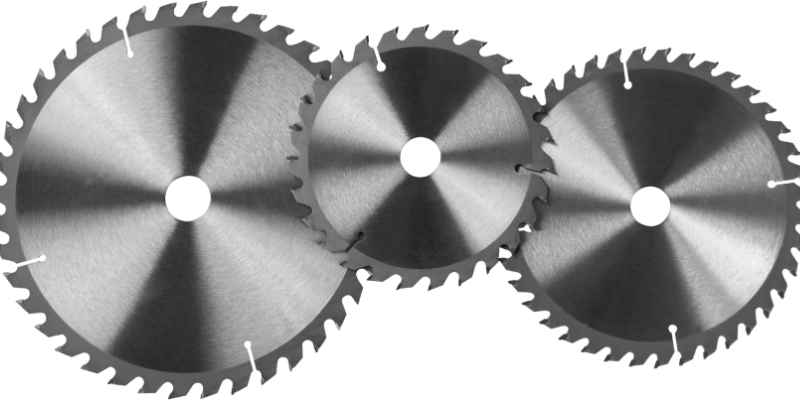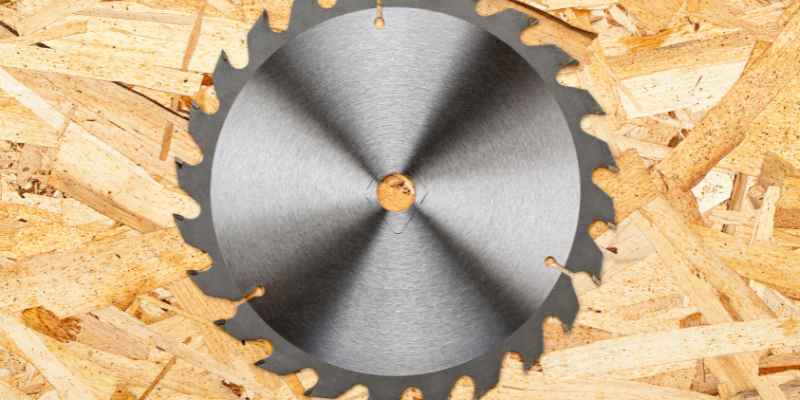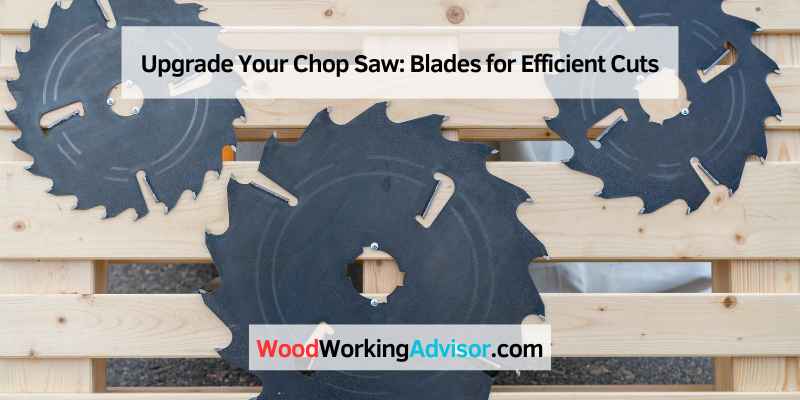Putting a steel cutting blade on a chop saw is not recommended as it can lead to accidents and malfunctions. Chop saws are powerful woodworking tools that are used primarily for cutting wood.
However, there are instances where they need to be used on other materials such as metal, plastic and masonry. While some people may be tempted to use them with different blades, it is not safe to do so as each type of blade is specifically designed for particular materials and applications.
This is particularly true for steel cutting blades, which have different speeds and motions than those intended for wood. We’ll explore why using a steel cutting blade on a chop saw is not advisable and the possible dangers it poses.
Types Of Blades For Chop Saws
Chop saws are versatile tools used in woodworking, metalworking, and masonry. However, to ensure their optimal performance, it is essential to use the right blade to avoid damaging the saw and the workpiece. There are different types of blades for chop saws available in the market, and each blade is designed to perform specific tasks and materials. Some of the common types of blades for chop saws are:

Circular Saw Blades
Circular saw blades are a popular choice for chop saws as they can cut through a variety of materials like wood, metal, plastic, and masonry. They are designed with different teeth configurations, cutting edge materials, and blade thicknesses, making them suitable for specific tasks. For instance, blades with fewer teeth are ideal for cutting through thick materials, while blades with more teeth are perfect for finer cuts.
Table Saw And Miter Saw Blades
Table saw and miter saw blades are versatile and come in various sizes and configurations. They are commonly used for woodworking tasks, like cutting boards, trims, and moldings. Miter saw blades are also suitable for making angled cuts, making them a popular choice for carpenters and framers. These blades are designed to cut cleanly and leave a smooth finish.
Metal Cutting Blades
Metal cutting blades are designed specifically for cutting through metal and come in two main types: abrasive and cold-cut. Abrasive blades are made from a composite material with abrasive particles, making them ideal for cutting through thin metal sheets or hard, non-metallic materials. Cold-cut blades, on the other hand, are made from alloy steel and are designed to cut thicker metals and leave a smooth finish. It’s important to note that metal cutting blades should never be used on wood as it can cause the blade to overheat or even fail.
In conclusion, understanding the different types of blades for chop saws and their specific applications can help you make an informed decision when selecting a blade for your project. Whether you are a professional craftsman or a DIY enthusiast, having the right blade for your chop saw can make all the difference in the quality and efficiency of your work.
Factors To Consider
When it comes to selecting blades for chop saws, it’s important to consider the type of material you’ll be cutting. Using the wrong blade can cause overheating and dulling, or even failure of the blade. Choose the appropriate steel or ferrous cutting blade for the best results.
When it comes to using a chop saw, one of the most essential components is the blade. It’s the blade that determines the type of material that can be efficiently cut. The blade should also be durable and long-lasting, even with frequent use. Several factors should be taken into account before selecting the right blade. These factors include the size of the blade, teeth per inch (TPI), blade material, and blade coatings.
Size of the Blade:
The size of the blade largely determines the material thickness that can be cut with a chop saw. Typically, chop saw blades come in various sizes, ranging from 8 inches to 14 inches. As a general rule, the larger the blade, the thicker the material it can cut. However, larger blades tend to be more cumbersome, and thus more challenging to use, than smaller ones. Moreover, the blade’s size needs to be compatible with the chop saw’s arbor size.
Teeth per Inch (TPI):
The number of teeth per inch (TPI) on a chop saw blade is another critical factor. Higher TPI count means more teeth that come in contact with the material being cut. Fewer TPIs mean fewer teeth come in contact, but the amount of material removed during each pass is more. Selecting the correct TPI for the blade is critical, as it is the TPI that determines the blade’s efficiency. Wood cutting blades, for instance, typically come with 24-80 TPI count, while metal cutting blades have fewer teeth with a TPI count of 6-18.
Blade Material:
The type of material used in creating a chop saw blade also weighs heavily on its overall performance. The type of material being cut determines the material of the blade. Carbide-tipped blades, for example, are excellent for cutting through metal, while high-speed steel (HSS) blades are better suited for wood. The blade’s material should be carefully selected as it will determine the blade’s longevity and efficiency.
Blade Coatings:
Coating on the blade enhances its durability and makes it more resistant to rust and corrosion. Common types of blade coatings include chrome, electrophoresis, and non-stick coatings. A coated chop saw blade can also help reduce friction and prevent workpiece material from sticking to the blade. Different types of coatings work better for different types of material being cut. For instance, electrophoresis coatings are ideal for cutting through metal.
In conclusion, selecting the right chop saw blade requires a careful consideration of several factors like the size of the blade, TPI count, blade material, and blade coatings. With the right blade, chop saws can accurately make precise and efficient cuts with ease.
Best Blades For Efficient Cuts
Efficient cuts require the right blades, especially when it comes to chop saws. Circular saw blades for wood, metal, and plastic are available on Amazon ranging from $29. 99 to $141. 22. However, it’s important to use the appropriate blade for the material being cut to avoid safety hazards.
Blades for chop saws are essential for efficient cuts. Choosing the right blade can make all the difference in the quality and speed of your work. In this article, we’ll discuss the best blades for efficient cuts and the benefits they offer. Let’s take a look at some of the top picks in the market.
Premium Grade Demolition Carbide Fire Rescue Saw Blades
These high-quality blades are designed for heavy-duty tasks. They are ideal for cutting through a range of materials, including wood, metal, and plastic. The Premium Grade Demolition Carbide Fire Rescue Saw Blades are incredibly durable, with carbide tips that can withstand heavy use and abuse. They also cut quickly and smoothly, thanks to their unique tooth design.
Evolution Tungsten-carbide-tipped Blades
These blades are perfect for cutting through thick metal. They are incredibly versatile, well-suited for cutting a range of materials, including wood, aluminum, and steel. The Evolution Tungsten-Carbide-Tipped Blades are designed to last a long time. They have unique teeth that make them more efficient at cutting through metal, reducing the time it takes to cut a piece of metal.
Steelmax Metal Cutting Saw Blades
These blades are some of the best when it comes to cutting through metal. They are designed to be durable and long-lasting, with unique tooth designs that can cut through thicker metal. The Steelmax Metal Cutting Saw Blades are also incredibly efficient, making them perfect for industrial use.
Whether you’re working on a DIY project at home or in an industrial setting, these blades are sure to meet your needs. They all offer unique benefits that make them stand out from other blades on the market. So, if you’re looking for the best blades for efficient cuts, look no further than these top picks.
Can Blades For Chop Saws Be Used With Miter Saws And Vice Versa?
When it comes to using blades for chop saws and miter saws interchangeably, it’s not recommended. Typically, chop saw blades are specifically designed for wood, while miter saw blades are used for making precise angled cuts in various materials such as wood, metal, and plastic.
It’s important to use the appropriate blade for each tool to achieve desired results.
Blades for Miter Saws
When it comes to miter saws, the type of blade you use is crucial in achieving clean, precise cuts for all your woodworking projects. Blades for miter saws are typically designed to cut through softer materials such as wood, plastic, and even some light metals like aluminum. The most common types of blades used for miter saws include crosscut, ripping, and combination blades.
Crosscut blades are perfect for achieving smooth cuts across the grain of the wood. While ripping blades, on the other hand, are designed to cut through the grain of the wood. Combination blades are versatile and can be used for both ripping and crosscutting.
Blades for Miter Saws can be found in a range of sizes, teeth counts, and materials, each designed to tackle specific projects with ease. Always make sure to use a blade that is appropriate for the material you are cutting to ensure optimal results.
Blades for Chop Saws
Chop saws are designed to make precise cuts through tough materials like metal and masonry. Blades for chop saws are typically made from heavy-duty materials like carbide and steel to withstand the force and high-speed rotations required to make these cuts.
There are two types of blades for chop saws: abrasive blades and cold cut blades. Abrasive blades are made with a composite material that disintegrates like a grenade blast when they fail under pressure. Cold cut blades, on the other hand, are designed to maintain their integrity under high stress conditions, making them an excellent choice for industrial applications.
When selecting a blade for your chop saw, it is essential to consider the type of material you will be cutting, and the thickness of the material. The right blade will help maximize efficiency while minimizing wear and tear on your saw.
Can Blades for Chop Saws be Used with Miter Saws and Vice Versa?
Although blades for chop saws and miter saws may look similar, it is essential to note that they cannot be used interchangeably. Blades for miter saws are designed specifically for woodworking projects, while blades for chop saws are designed for tougher materials like metal and masonry.
Using a chop saw blade on a miter saw, or vice versa, can lead to disastrous results, including overheating, dulling, and even blade failure during operation. Always ensure you are using the right blade for your saw, and the material you will be cutting to ensure optimal results and safety.

Frequently Asked Questions For Blades For Chop Saws
Can You Put A Steel Cutting Blade On A Chop Saw?
No, putting a steel cutting blade on a chop saw is not recommended. Chop saws are designed to cut wood and run at specific RPMs. Metal cutting blades are designed for different speeds and can disintegrate or fail if used on a chop saw.
Can You Put A Wood Blade On A Chop Saw?
It is not recommended to put a wood blade on a chop saw for cutting metal. The speed of the blade is specific to the task, and abrasive and cold cut metal blades are designed to run at different speeds.
Using a wood blade on metal may cause it to overheat, dull quickly, seize, or shatter.
What Is The Best Blade For Cutting Metal?
The best blade for cutting metal is a cold cut blade or an abrasive blade. It is not recommended to use a wood cutting blade on a metal chop saw as it may overheat and shatter. It is also not recommended to put a metal cutting blade on a wood chop saw as the blade’s speed is specific to the task.
What Are Different Blades For On A Miter Saw?
Different blades for miter saws serve different purposes. Wood cutting blades are ideal for cutting through wood, whereas metal cutting blades are used for cutting metal. Abrasive and cold cut metal blades are designed to be run at different speeds and would not work efficiently on a wood chop saw.
It is not recommended to interchange blades between chop saws and miter saws.
Conclusion
To sum it up, selecting the right blade for a chop saw is a crucial decision. The blade must be specific to the material you want to cut and must match the speed of the chop saw to avoid overheating or dullness.
It’s essential to understand the differences between blades and never use a woodcutting blade on a metal chop saw and vice versa. Therefore, always ensure that you have the correct blade for the task at hand to prevent hazards and deliver precise cuts.


